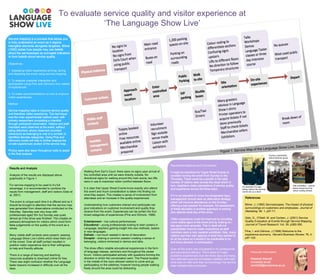To evaluate service quality and visitor experience at ‘the language show live’
- 1. To evaluate service quality and visitor experience at Service mapping is a process that allows you to fully understand an event as it depicts intangible elements alongside tangibles. Bitner (1992) states how people may use beliefs about the servicescape as surrogate indicators to form beliefs about service quality. Objectives - 1. Assessing visitor experience arriving, during and departing the event using service-mapping. 2. To analyse customer interaction and participation using Pine and Gilmore’s four realms of experiences. 3. To make recommendations on how to improve visitor experiences. Method Service mapping helps to improve service quality and therefore visitor experience. This technique was the main experimental method used, with primary researchers completing a checklist through participant observation. Visitors and staff members were observed at the event, without being disturbed, where observers recorded behaviours as belonging to one of a number of identified discrete categories. Using Pine and Gilmore’s model will help to further analyse the on-site experiences section of the service map. Photos were also taken throughout visits to assist in the final analysis. ‘The Language Show Live’ Results and Analysis Analysis of the results are displayed above graphically in Figure 1. For service-mapping to be used to it’s full advantage, it is recommended to combine the inputs from management, staff and visitors (Getz et al, 2001). The event is unique each time it is offered and so it should be brought to attention that the service map was generated from observations conducted on the Saturday. Saturday was very busy with professionals aged 30+ but Sunday was quiet, almost as if the show was finished. This creates an awkward atmosphere for visitors which could form false judgements on the quality of the event as a whole. Many visible staff contacts were present, wearing Language Show Live t-shirts which drew them out of the crowd. Over all staff contact resulted in positive visitor experience due to their willingness to help and friendly attitude. There is a range of learning and teaching resources available to download online for free. There was slight confusion whether the Language taster lessons increased in difficulty over all the days. References Bitner, J. (1992) Servicescapes: The impact of physical surroundings on customers and employees. Journal of Marketing. 56, 1, p57-71. Getz, D., O’Neill, M. and Carlsen, J. (2001) Service Quality Evaluation at Events through Service Mapping, Journal of Travel Research. Vol. 39, p380-390. Pine, I. and Gilmore, J (1998) Welcome to the experience economy, Harvard Business Review. 76, 4, p97-105. Personal Information Rebekah Marnell University email: rem0348@londonmet.ac.uk Recommendations and Conclusion It might be beneficial for Upper Street Events to consider moving the event from Sunday to the Thursday. There could be a growth in the total number of visitors seen across the show which in turn, heightens visitor perceptions of service quality and experience across the three days. If it is not plausible to move the designated days, management should seek an alternative strategy which will improve attendance on the Sunday; offering a key speaker for example. Re-assessment of ticket allocation is another approach to solving who attends what day of the show. Visitor experience could be improved by providing more visible signs to the event and by making on-site signs more accurate. This in itself will not substantially improve visitor experience as staff members were a very capable substitute. Also, many visitors had their own agenda of what they wanted to do at the event so it wouldn’t be practicable to try and force direction or participation. Over all the event was successful in it’s professional and educational delivery. There were no major problems experienced over the three days and many who attended seemed completely satisfied with both what was on offer and their surroundings; the service map validates this conclusion. Walking from Earl’s Court, there were no signs upon arrival of the controlled area until we were directly outside. No directional signs for walking around the main arena; two lifts were in use to maximise visitor comfort between floors. It is clear that Upper Street Events know exactly who attend this event and much consideration is taken into finding out what they expect. This creates a sense of involvement from attendees and an increase in the quality experienced. Understanding how customers interact and participate can give indications on customer involvement and quality they receive from the event. Experiences can be sorted into four broad categories of experiences (Pine and Gilmore, 1998). Entertainment – live cultural performances. Educational – young professionals looking to start careers in Language, teachers gaining insight into new methods, tasters in new languages. Esthetic – not much needed in terms of decoration. Escapist – sharing a common passion creating a sense of belonging, visitors immersed in demos and talks. The show offers notable educational experiences in the form of language classes, seminars and throughout the career forum. Visitors participated actively with questions forming the direction in which the conversation went. The Piazza located in the middle of the room allowed visitors to come and go participating on the sidelines; however having people walking freely around the area could be distracting. An example of a sign telling visitors the seminar rooms are up a level Site orientation – picture below shows how the colour coding worked During a particularly active seminar group
